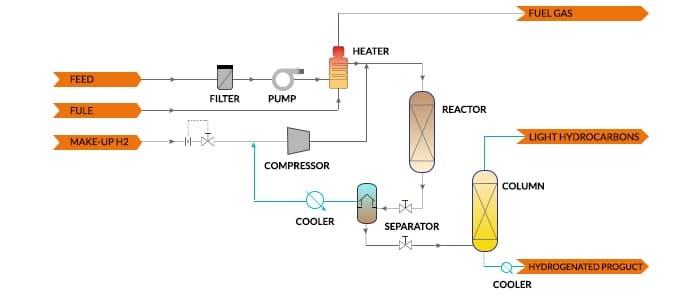Hydrogenation
Sequoia’s Expertise for Hydrogenation Projects
- Design and supply of all equipment, steel, pipes, instruments and controls under one lump-sum contract.
- Industry-standard selection of metallurgy and safety systems.
- Vendors with proven experience.
- Every plant is custom designed.
- Modularization (skids) to the extent possible.
- Active support to Operations for years.

Sequoia has strong experience and capabilities to use the approach as described above, for the following applications:
Hydrogenation of Lube Oil Base Stocks and Vacuum Gasoil to Group II+, III base oils
- The design goal is production of Group II or Group III base oil from feedstock such as solvent neutral (Group 1) base stocks, vacuum gas oils distilled from crude or used oils.
- Sulfur and nitrogen removal as well as aromatics saturation.
- Sequoia has experience with capacities from 300 to 12000 bbl/day.
Hydrogenation of Bio-feedstock / Renewable Diesel (HDRD)
- Traditional biodiesel production via trans-esterification using methanol produces an oxygenated fuel which cannot be mixed with fossil-fuels. Glycerol is the byproduct. Free fatty acids (FFAs) present in bio-feedstock produce soaps in this process scheme.
- Hydrogenation-derived renewable diesel (HDRD) is produced by hydrogenation (reaction with hydrogen) of oxygenated compounds (triglycerides) to produce fully-saturated hydrocarbons in the boiling range of diesel. Water, propane, CO and CO2 are the byproduct of the reactions. Soap production from FFAs is not a concern.
- Net result is production of “drop-in” renewable diesel fuel meeting standards by ASTM (D975) and ISO. This means producing bio-feedstock derived fuel compatible with fossil-fuels so they can be mixed, used inter-changeably. Indeed, in the USA, the HDRD produces higher renewable credits than biodiesel.
- HDRD can be produced from any type of bio-based feedstocks such as vegetables oils, animal fats (wider than biodiesel production options). HDRD can be produced from lignocellulosic feedstocks such as from agricultural, papel-pulp residues.
- Sequoia can design and deliver all equipment for hydrogenation of bio-feedstocks for HDRD production.

Sequoia’s Expertise for Hydrogenation Projects
- Main objective is reduction of sulfur from oil.
- Aromatic saturation is necessary to produce Ultra-Low Sulfur Diesel (ULSD) meeting latest specifications.
Hydrogenation of Naphthenic Oil and
waste transformer oils
Hydrogenation in combination with vacuum drying and filtration is the most complete and advanced process technology for recycling of waste transformer oils. In the Hydrogenation process, hydrogen gas reacts with sulfur, nitrogen, chlorine and other unsaturated compounds present in waste transformer oil, producing a water-white, stable product with low sulfur concentration and superior insulating properties.
- Sequoia understands how to preserve the desirable inherent characteristics of naphthenic oils during hydrogenation process and target only the undesirable compounds in the spent oil.
- Sequoia’s hydrogenation technology will almost completely destroy carcinogenic organic chlorine compounds such as PCBs (Polychlorobiphenyls) often present in waste transformer oils.
- The resulting base oils can meet rigorous OEM specifications of transformer oils in USA, Europe and Japan.

